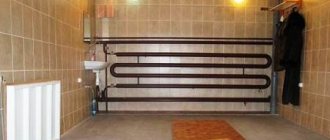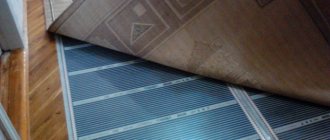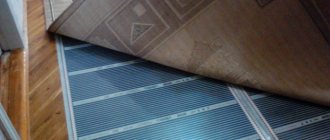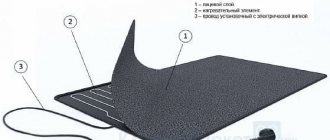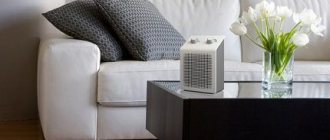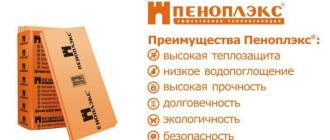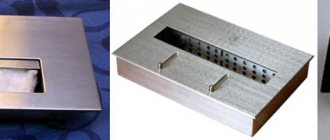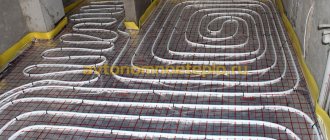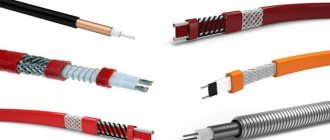- home
- Articles
- Is it possible to lay a carpet on a heated floor?
Warm floors have long and quite firmly entered our lives. Now they no longer look like a luxury, but rather a tribute to comfort and concern for the health of their loved ones. Of course, their installation raises questions among the consumer, and one of the most common of them is - is it possible to cover a heated floor with a carpet? For example, a mat does not cause such difficulties, but some people are afraid to place a dense textile covering on heating equipment. Are these fears justified or can they be ignored?
Initial data
Both components of our question have a centuries-old history. Warm floors appeared in Ancient Rome, but they have been widely used since the eighties of the last century, when polymer pipes were invented.
The variety of power supply principles for such heating systems allows them to be used both in a private home and in an apartment. The choice of device depends on the customer's preference.
Warm floors are divided into stationary and mobile.
Stationary ones, depending on the heating element, are water, electric and infrared. Their installation requires special knowledge, preliminary preparation of the layout of heating sections and a thermostat, and a flat floor surface. The role of the final coating element, protecting the heating system from mechanical stress during operation, is best handled by tiles, marble or stone.
Mobile heated floors do not require special dismantling. Available in the form of mats or panels. There are infrared and resistive.
Carpets are made from artificial and natural materials and have different pile structures, colors, designs and shapes. With all their diversity in the house, they perform two functions:
- floor insulation;
- decorative element.
The former have a dense structure, long pile, and low thermal conductivity. The latter are a key detail of the interior, so the main criterion for their selection is the style of the room. To harmonize with the overall design of the house, the flooring product can be made from both traditional materials - wool, polyester, acrylic, cotton, linen, and unusual ones - leather, seaweed, banana silk, rice.
Is it possible for the two components to fully perform their functions during operation will be the answer to our question.
Advantages
A carpet laid on a warm floor is more convenient than its stationary counterpart:
- he is mobile. Portable models are easy to move from one place to another. This is a significant plus, especially in a large family where circumstances change every day;
- easy to install. You just need to spread the electric carpet on the floor and plug the system into a power outlet;
- can change temperature. There is a thermostat for this, which is very easy to control;
- safe for the whole family. The temperature on the surface of the portable mat does not exceed 30 0. Therefore, even for small children this option is preferable to other heating systems;
- economical. The energy consumption per square meter is approximately 250 W. It should be taken into account that the larger the size of the mat, the larger the quantities we will be talking about;
- strength. The product is durable and does not wear out;
- efficiency. Efficiency is almost 90%;
- environmental friendliness. The heating device does not dry out the air, which is very important for people with allergies or asthma.
Of course, there are also disadvantages. Furniture cannot be placed on the system; it does not tolerate high pressure. In small apartments this can be critical. In addition, laying such a floor requires a prepared, flat surface.
Under what circumstances is it impossible
If the choice fell on water or electric floors as the main heating system, then a thick carpet with a large pile or carpet will reduce their efficiency. In this case, water ones will work with low efficiency, but electric ones may burn out.
The carpet will also lose its visual appeal and become deformed, especially if it is based on synthetic materials.
If you can’t imagine your life without a luxurious thick-pile wool carpet and at the same time without heated floors, the solution may be to install a rod or graphite floor. The innovative heating system is equipped with a temperature regulator and its “cooperation” with an additional coating will be successful. True, such pleasure costs a lot of money.
It's cold in a room with water floor heating
We have a water-type heated floor, there is no other heating. After laying down the fluffy rug, it became cold. Is it possible to lay a carpet on a water floor?
Products made from long-pile carpet are good heat insulators. You freeze because the water floor, the only source of heating, transfers all the heat to the palace, and not to you.
Is it possible to lay a carpet on a water floor? Yes, but thin, which allows heat to pass through. At the same time, its base material must be of high quality, otherwise it is in danger of deformation. Among the suitable models, we recommend you the Opera rug carpet with a pile height of 3 mm.
Now you know how to select carpets for heated floors, and we hope such problems will not affect you.
When is it possible
For stationary heating systems operating on water, thin carpets with reduced thermal insulation are suitable. Their material must be of high quality and natural, since temperature changes deform the product.
The situation is different with electrically powered systems. For it to work effectively, the heated surface must be almost completely open. It is acceptable to use dim small decorative or bedside rugs. Otherwise, the heating elements will burn out and the fabric covering will burn out.
Mobile floors work well with carpeting. The installation technology requires covering them with a carpet. But it will still be safer if the carpet has a medium density or is made of heat-resistant synthetics.
It is possible to solve the problem of mutual happy existence of a carpet and a warm floor. To do this, you need to listen to the advice of experts, show imagination and ingenuity.
Carpet Floor
Types and varieties
Before installing an electric heated floor, you will have to think a lot. The number of models on the market is such that it is impossible to decide on such a coating without preparation. Experts distinguish several types of heating systems:
- stationary. They are laid under a coating with high thermal conductivity. This could be ceramic tiles or special types of laminate;
- mobile. They can be placed in any place convenient for you and moved. This floor can be covered with acrylic carpets or other covering of your choice.
Obviously, a warm floor under a carpet is a mobile option. But there is one more factor that must be taken into account. This is the type of palace itself:
- warm. This type includes long-pile models with low thermal conductivity;
- decorative, whose main task is not to warm, but to decorate the apartment. These can be openwork mats or other carpet models.
Deciding what to lay something on a warm floor can only be done with the right combination of two factors - the type of covering and the type of carpet.
Tips for choosing ITP
Before purchasing a heated floor, you need to pay attention to the following points:
- Reliability of insulation. In the case of film ITP, it is advisable to try to delaminate the insulation yourself. If you can do this manually, the film is of poor quality. The same applies to rod heated floors. The rods should not fall out of the insulation due to simple force. In both cases, high-quality insulation can only be broken with a knife.
- Reliability of contacts. Does not apply to the core ITP, since all contacts there are insulated and invisible. In film IHP, you must try to “break” the contact by bending the film at the junction of the conductive and heating strips.
- Width of conductive and heating strips. The wider both elements are, the more reliable the system is and the better it heats the room.
- Appearance. There should be no debris under the film, even the smallest. The carbon strips must have the same shape, the same size and the same structure. In addition, there should be no damage on the surface of the film: dents, punctures, cuts, cracks, and so on. All this can break the tightness of the insulation.
When choosing, it is necessary to take into account the characteristics of each type of ITP. For example, it is not recommended to lay infrared film heated floors in a bathhouse, as they are susceptible to dampness. If the insulation leaks, dampness can lead to a short circuit.
Striped film flooring is not placed under massive furniture. This threatens to overheat the floor covering, which will lead to its damage. Either no ITP is installed under the furniture at all, or a carbon heated floor (film or rod) is installed.
In apartments (houses) with low ceiling heights, using a rod-based heated floor is simply irrational. It requires a screed of at least 2-3 centimeters, which will also reduce the distance between the floor and the ceiling. On the other hand, rod ITP can be laid on a slightly uneven surface, then it will be leveled using the same screed.
In a room where there are a lot of curves, bends, turns, and so on, it is better to take a carbon film floor that can be trimmed. You can also take carbon ITP, but part of the space, one way or another, will remain unfilled.
How to use mats?
The operation of a mobile “warm floor” is simple. If the purchase was brought from the cold to a warm room, then it must be kept for several hours to acclimatize. After time has passed, the mat is straightened out.
If a plug is attached to the cable, then it is simply connected to the network. “Warm flooring” is laid under a carpet or rug. The system starts to work and heats up the coating.
The cable that is connected to the mat may not have a plug. The kit includes a thermostat. The conductor is connected to it. The thermostat is connected to the network. There is a control unit on it. Use the buttons to set the heating mode. The system works automatically.
If the temperature exceeds the set mode, it turns off. When the “warm floor” mat cools down, the heating turns on again on its own.
You can install chairs, a table, and boxes with toys on the mats. The manufacturer assures that the cable will not be blocked. It won't overheat. You can easily move around on the carpet or actively play on it.
For a “warm floor” under a carpet, no additional equipment is required. The system heats only the area in which it is located. The remaining zones remain cool.
Mats with an electric cable or carbon coolant are not recommended to be bent. This may destroy the heating element. It is not recommended to use a mobile mat if there are pets in the house that could disrupt the integrity of the conductor. The mat is not cut or the protective covering is removed.
If the system stops functioning, contact the service center; The address is indicated in the technical passport. The warranty period for mobile “warm floor” is 2 years. Operational period 7-10 years.
Warm floor under carpet on wooden floor
If there is a subfloor made of wood, and it is not permissible to increase the load on it, it is possible to install a heated floor under the carpet in a “dry” manner. It is allowed to install both water and electrical systems.
Pipes or cables are installed on a wooden floor in grooves prepared from slats. The size of the openings must be equal to the thickness of the heating elements. You can install ready-made modules on a wooden floor, into which the heater will be installed.
There is another way - grooves are cut into polystyrene foam, it will simultaneously serve as insulation and prevent heat from escaping through the subfloor. On top, this structure is covered with plywood or chipboard sheets on which the carpet will be laid.
Infrared heated floors can be laid directly on a wooden base, then covered with plywood and carpet.
For your information! To eliminate unexpected heat costs or keep them to a minimum, it is recommended to lay a foil film between the heating elements and the subfloor, which will reflect infrared rays upward.
It is possible to use carpet in combination with warm floors if the requirements for the material are properly met. The structure of the coating must have a porous and natural base. Such a product will not interfere with the passage of heat so much.
However, you will need to regularly clean the carpet to prevent dust mites from infesting it. But this drawback is compensated by the comfort of the floor at any time of the year.
Installation of infrared heated floor under carpet
Warm floor CALEO (Kaleo) - video instructions for installation under linoleum and carpet
Infrared heated floors, as mentioned above, are one of the most suitable options for installation under carpet. In addition, you can install this system yourself. The covering is assembled from separate elements.
Step-by-step installation of an infrared structure under a carpet looks like this:
- preparation of the base - by repairing the existing concrete screed or installing plywood flooring;
- laying foil insulation;
- placement of film elements according to the manufacturer’s instructions;
- connecting and checking the system;
- pouring a very thin concrete screed or applying an adhesive composition;
- laying out the carpet.
At this point, work on installing the heated structure under the carpet is completed. And you get a warm and soft floor.
Heating elements under the carpet
With radiator heating, heat is distributed unevenly throughout the room. Hot air rises, cools, and sinks to the floor. The flooring remains cool.
In order to heat local areas, a “warm floor” system is installed. To do this, you need to open the floor covering, prepare the rough covering, and lay all the insulating materials.
Manufacturers of heating systems offer the use of mobile “warm floors”. It has the following structure:
- a separate mat with a conductor built inside; it can be a cable, thread or carbon strips;
- The coolant is protected by an additional coating from moisture penetration and prevents mechanical stress;
- the mats are equipped with a cable that connects to the power supply via a socket or temperature control device;
- maximum warm-up temperature 55 0C;
- mats are placed under the carpet.
If necessary, the mat can be easily rolled up and placed in a portable bag. The system is used to heat the bedside area, under the carpet in the children's room, and in the bathroom. You can take it with you to the country house or to the office. The heater operates on a voltage of 220 V. Power is 250-300 W/h.
We recommend: How to make a warm floor from a heated towel rail?
DIY heated mat
Many people do not have the opportunity to make repairs or install expensive floor heating systems. But everyone wants to live in a warm apartment or house and walk on a heated floor. You can make a heated mat yourself. It may include laminate, carpet and heating devices.
The linoleum will become a protective layer - it should be cut according to the size of the rug.
It is quite possible to make a heated mat with your own hands if you approach this process correctly.
For radiation and energy conservation, special thermal insulation (roll) is used. You need to cut a piece out of it that matches the size of the protective layer. The two layers are secured together using glue or double-sided tape.
What you will need:
- Linoleum;
- Rolled infrared thermal insulation;
- Glue or double-sided tape;
- Cable.
There is no need to install a mobile mat - this is its main advantage. Heat will be available anytime, anywhere. In addition, mobile flooring is available to absolutely everyone.
Heater under the carpet: main advantages
Many people use a mobile floor when they do not want or do not have the opportunity to install a stationary heating system. Such heaters can be laid under different coverings, for example, linoleum or laminate. It is important to consider that thermal conductivity depends on the quality and thickness of the coating.
If the heater is laid under carpets, it is desirable that they be lint-free or woven.
The main advantages of a floor heater are that it is mobile and easy to use.
The most effective thermally conductive coatings are laminate, linoleum, ceramics, stone or metal-based tiles. The heaters consist of a front layer, a substrate, a flexible heating element, and a power box. Heating mats are sold together with power regulators.
Heater advantages:
- Mobility. It doesn't take long to install.
- Ease of use. It is practical and functional.
- Comfort. Allows you to set a comfortable temperature regime.
- Safety. Meets European standards.
When purchasing heaters, it is important to pay attention to quality certificates. You should not save money and buy heaters without a warranty period. It is important to remember that the device must be safe, and this can only guarantee high quality.
Manufacturers
Mobile floor heating systems are produced both in Russia and in Europe and China. All companies are constantly improving the designs of heating devices.
Our most popular products are domestic ones.
Teplolux Express
Teplolux (Russia) is the leader in sales of mobile floors; the most popular product is Teplolux Express. This model range is used for various flooring materials; laying laminate, carpet, linoleum, and even tiles is possible.
This type of rug has a front side made of elastic artificial felt, so it is easy to twist. The weight of the floor is about 3 kg, with a power of 300 to 560 W. The product is equipped with a wire, its length is 2.5 meters.
A huge plus is the presence of a special thermostat on which you can set the temperature for each day of the week. This allows you to save up to 70% of electricity.
NICK SINION
LLC "NIK SINION" (Russia) - produces film heating devices SinPlen, standard size 5 - 6 m2. They operate from a 220 V power supply. The power of these floors is 280 W per m2, which allows you to fully heat the room covered with a heating mat by 30%.
Trio
Specialization (Ukraine) - small mobile devices (1.8 x 0.6). These floors are effective, economical, and affordable; they are suitable for spot heating in small rooms (bathtub, balcony).
Good warmth
The main direction of the company is portable infrared floors measuring 80 by 50 cm, the power of which is 220 W. The main advantage of the brand is a huge palette of designs, a variety of colors and a variety of patterns.
The floor is economical, safe, and works even in a damp room. The product can be used for drying shoes and in rooms where vegetables are stored.
Warm house
The Viks model is popular among products.
This is a carpet mat with a colored coating on both sides, which allows it to be laid even in a damp room. Installation is simple - just lay the product down and connect it to the network.
Sinplain
Sinplen is a mobile heated floor that is in great demand among customers. It is only 0.6 ml thick, but this does not affect the quality of heating and wide temperature range. Pairs perfectly with laminate and carpet.
In addition to the standard length, the manufacturer accepts orders for custom-sized rugs.
